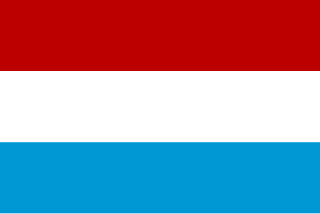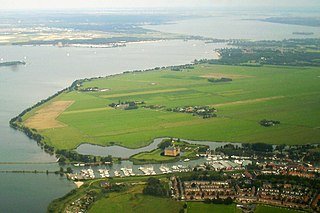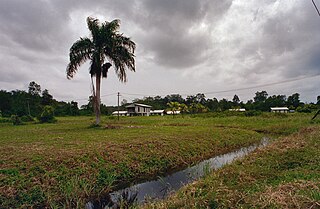This page is based on this
Wikipedia article Text is available under the
CC BY-SA 4.0 license; additional terms may apply.
Images, videos and audio are available under their respective licenses.

New Amsterdam was a 17th-century Dutch settlement established at the southern tip of Manhattan Island that served as the seat of the colonial government in New Netherland. The factorij became a settlement outside Fort Amsterdam. The fort was situated on the strategic southern tip of the island of Manhattan and was meant to defend the fur trade operations of the Dutch West India Company in the North River. In 1624, it became a provincial extension of the Dutch Republic and was designated as the capital of the province in 1625.

New Netherland was a 17th-century colony of the Dutch Republic that was located on the east coast of America. The claimed territories extended from the Delmarva Peninsula to southwestern Cape Cod, while the more limited settled areas are now part of New York, New Jersey, Delaware, and Connecticut, with small outposts in Pennsylvania and Rhode Island.

Amstelveen is a municipality in the province of North Holland, Netherlands with a population of 89,918 (2017). It is a suburban part of the metropolitan area of Amsterdam.

Muiden is a city and former municipality in the Netherlands, in the province of North Holland. It lies at the mouth of the Vecht and is in an area called the Vechtstreek. Since 2016, Muiden has been part of the new municipality of Gooise Meren.

Uitgeest [œy̯tˈxeːst] (listen) is a municipality and a town in the Netherlands, in the province of North Holland.

Amsterdam is a town in Montgomery County, New York, United States. The population was 5,566 at the 2010 census. The town is named after Amsterdam, the capital of the Netherlands.

Hoofddorp is the main town of the Haarlemmermeer municipality in the province of North Holland in the Netherlands. In 2009, the population was just over 73,000. The town was founded in 1853, immediately after the Haarlemmermeer had been drained. Hoofddorp is located 52° 18′ 21.96″ N and 4° 41′ 26.52″ E.

Delaware Colony in the North American Middle Colonies consisted of land on the west bank of the Delaware River Bay. In the early 17th century the area was inhabited by Lenape and possibly the Assateague tribes of Native Americans. The first European settlers were the Swedes and the Dutch, but the land fell under English control in 1664. William Penn was given the deed to what was then called "the Lower Counties on the Delaware" by the Duke of York, in a deed separate from that which he held for the larger Province of Pennsylvania. Delaware was then governed as part of Pennsylvania from 1682 until 1701, when the Lower Counties petitioned for and were granted an independent colonial legislature, though the two colonies shared the same governor until 1776, when Delaware's assembly voted to break all ties with both Great Britain and Pennsylvania.

Commewijne is a district of Suriname, located on the right bank of the Suriname River. Commewijne's capital city is Nieuw Amsterdam. Tamanredjo is another major town.

The UNESCO World Heritage Site known as the Defence Line of Amsterdam is a 135 km ring of fortifications around Amsterdam. It has 42 forts that are 10-15 km from the centre and lowlands, which can easily be flooded in time of war. The flooding was designed to give a depth of about 30 cm, too little for boats to cross. Any buildings within 1 km of the line had to be made of wood so that they could be burnt and the obstruction removed.
Fort William may refer to:

Fort Orange was the first permanent Dutch settlement in New Netherland; the present-day city of Albany, New York developed at this site. It was built in 1624 as a replacement for Fort Nassau, which had been built on nearby Castle Island and served as a trading post until 1617 or 1618, when it was abandoned due to frequent flooding. Both forts were named in honor of the Dutch House of Orange-Nassau. Due to a dispute between the Director-General of New Netherland and the patroonship of Rensselaerswyck regarding jurisdiction over the fort and the surrounding community, the fort and community became an independent municipality, paving the way for the future city of Albany. After conquest of the region by the English, they soon abandoned Fort Orange in favor of a new fort: Fort Frederick, constructed in 1676.
Athenaeum referred to the Athenaeum, a school in ancient Rome. It may also refer to:

Berbice is a region along the Berbice River in Guyana, which was between 1627 and 1815 a colony of the Netherlands. After having been ceded to the United Kingdom in the latter year, it was merged with Essequibo and Demerara to form the colony of British Guiana in 1831. In 1966, British Guiana gained independence as Guyana.

New Netherland Company was a chartered company of Dutch merchants.
Fort Wilhelmus was a factorij in the 17th-century colonial province of New Netherland, located on what had been named Hooghe Eyland on the Zuyd Rivier, now Burlington Island in the Delaware River in New Jersey.
More a trading post than a military installation, it was built in 1625 by colonists from the Netherlands in the employ of the Dutch West India Company, with the intention of establishing a physical claim to the new territory and to engage in the fur trade with the indigenous population of Lenape and Minqua. The Walloon families had originally arrived at Noten Island across from Fort Amsterdam in the Upper New York Bay, They had been sent south in order to begin the population of the province of New Netherland. They were later recalled to New Amsterdam since the Dutch West India Company had decided to concentrate their settlement efforts along the North River, or Hudson River.

Fort Nassau was the capital of the Dutch colony of Berbice, in present-day Guyana. It was situated on the Berbice River approximately 88 kilometres upstream from New Amsterdam.

Suriname-Rivier is a lightvessel permanently berthed in a wet dock in the Fort Nieuw-Amsterdam Open-Air Museum in Nieuw-Amsterdam, Commewijne, Suriname.

















